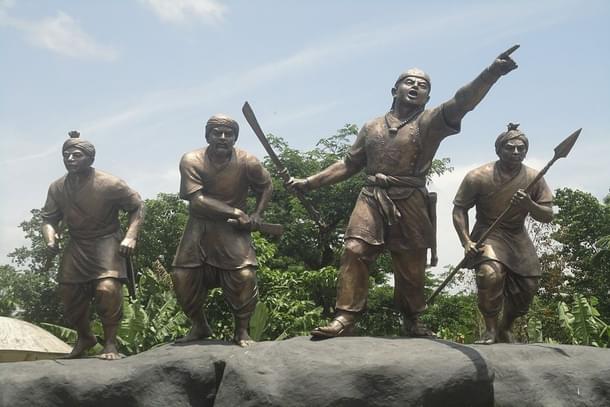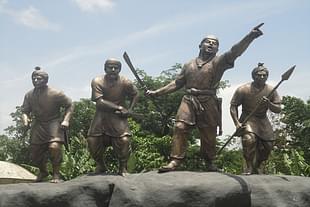Commentary
Had It Not Been For Legendary Assamese General Lachit Borphukan, Northeast Would Not Have Been Part Of India
Jaideep Mazumdar
Nov 21, 2022, 04:57 PM | Updated 04:57 PM IST
Save & read from anywhere!
Bookmark stories for easy access on any device or the Swarajya app.


India’s eastern boundary would have stopped at the Bengal-Assam border had it not been for the legendary 17th century Ahom General Lachit Borphukan whose 400th birth anniversary celebrations will begin this week.
In fact, history would have taken a different turn, and a turn for the worse, if Borphukan (born on 24 November 1622) had not inflicted a crushing defeat on the Mughals in the 1671 Battle of Saraighat.
The consequences of a Mughal victory in that decisive battle would have been horrific for Assam and the entire Northeast and for India as well.
Why The Defeat Of Mughals Saved Assam And Northeast
The 1671 Battle of Saraighat between the Ahoms and the Mughals was a decisive one since the Ahoms inflicted a devastating drubbing on the Mughal forces from which the latter never really recovered.
Though the 1671 battle was not the last faceoff between the Ahoms and Mughals — the last battle between the two sides was fought in 1682 — it set the stage for the exit of the Mughals from the kingdom of Asom.
‘Mahaveer’ Lachit Borphukan deployed a brilliant combination of guerilla tactics, subterfuge, diplomacy, daring and psychological warfare to defeat the much larger army of Mughals.
The 1671 battle dealt a huge psychological blow to the Mughals and destroyed the myth of their invincibility.
Had the outcome of the battle been different and the Mughals won, the Muslim victors would have exacted terrible revenge on the Ahoms who had displayed a fiercely independent streak.
The Ahoms had resisted concerted attempts by the Mughals for nearly six decades to subjugate them and make the kingdom of Ahom a vassal state.
Before the 1671 battle, the two sides had fought many times with mixed results. But every time and irrespective of the outcome, the Mughals suffered considerable losses in terms of men and material.
Every skirmish with the Ahoms, even when the latter were defeated, left the Mughals drained and frustrated because the Ahoms deployed guerilla tactics and subterfuge that very often caught the Mughals completely unawares. The result was that Mughals always suffered heavy losses even if they won the battle.
Had the Mughals won the decisive battle of Saraight in 1671 and defeated Borphukan, they would have massacred the Ahoms, including non-combatants. And raped and taken away all women as sex slaves while forcing all surviving men and children to convert to Islam.
That is how the Mughals, and invading Muslim armies across the world, used to treat the vanquished who used to put up a stiff defence and resist their attempts at subjugation. History is replete with many examples of such brutality inflicted by Muslim armies on the ‘kafirs’ they defeated.
Not only would the Ahoms have been forcibly converted to Islam, they would have been deluged by Bengali-speaking Muslims from the neighbouring Mughal-ruled province of Bengal.
Bengal, even during the rule of the nawabs, was densely populated and the peasantry, especially the Muslim peasantry in the eastern part of the province (which is now Bangladesh), were desperately poor.
Asom (Assam) had always been a rich kingdom with vast swathes of fertile and arable land lying fallow. The poor Muslim peasantry of (eastern) Bengal had always eyed Asom to migrate to and settle down in.
They couldn’t because the Ahoms were fiercely independent and would never allow such migration.
The British brought Assam under their rule in 1824 and that paved the way for a slow trickle of Bengali-speaking Muslims into some parts of lower Assam.
This trickle turned into a deluge in 1905, when the British partitioned Bengal and grouped East Bengal (present-day Bangladesh) and Assam together under a ‘Chief Commissioner for Eastern Bengal and Assam’. The British also encouraged this largescale migration in order to increase Assam’s agricultural output.
But the Assamese were able to retain their distinct identity and culture even in the face of such large-scale migration of Muslims speaking a different language, only because they defeated the Mughals in 1671.
Had that not happened, Assam would have become a Muslim-majority province by the turn of the last century and most of its residents would have been Bengali-speaking Muslims. It would have, effectively, become part of East Bengal.
And that means that Assam would have gone to Pakistan and become part of East Pakistan in 1947.
With Muslim-majority Assam being integrated into Pakistan, independent India would have lost access to the vast tribal areas of the Northeast (which are now the other six states of the region excluding Sikkim). And most probably, the tribal areas would have become small independent states.
These independent tribal countries would have been far too weak to resist being gobbled by Pakistan. At best, they would have come under the exclusive influence of China.
Present-day Arunachal Pradesh and Nagaland would, undoubtedly, have become part of China (or Chinese-occupied Tibet).
India’s eastern border would, thus, have extended till Coochbehar in Bengal, And with Assam being its part, Pakistan would have been a more powerful country than what it is now.
The 1971 dismemberment of Pakistan may not have happened at all.
India, consequently, would be living with a very hostile and powerful neighbour, on both its western and eastern flank. That hostile neighbour, with China as its close friend, would have been causing a lot of trouble —much more than what it has been doing over the past few decades — for India.
All these nightmarish scenarios have not unfolded because of the bravery, intelligence and prowess of Mahaveer Lachit Borphukan. India owes a debt of gratitude to this hero who, unfortunately, is not known and revered enough outside Assam.
Making The Anniversary Celebrations National
The obsession with the Nehru-Gandhi family and extolling Jawaharlal Nehru’s contribution to India’s Independence to the virtual exclusion of other heroes has resulted in many white knights in the country remaining unsung.
And so it has been with Mahaveer Lachit Borphukan as well. Successive Congress regimes in Assam also limited the celebrations of this hero who actually saved Assam and its people from disaster within the boundaries of the state.
This is now being set right by the present Assam Chief Minister, Himanta Biswa Sarma. He is holding the Mahaveer Lachit Borphukan’s 400th birth anniversary celebrations at the national level.
Prime Minister Narendra Modi will attend one of the events on 25 November, while Union Finance Minister Nirmala Sitharaman will inaugurate an exhibition on Borphukan in New Delhi on 23 November.
Union Home Minister Amit Shah will be the chief guest at the event. Many other programmes to be attended by other ministers, including Union Law Minister Kiren Rijiju, are slated for the three-day celebrations from 23 November.
“We have requested the NCERT to include a chapter on Lachit Borphukan in school and college history textbooks. I have also requested the Army Chief to institute a bravery award in the name of the great hero and to have an annual lecture in his memory,” said Sarma.





